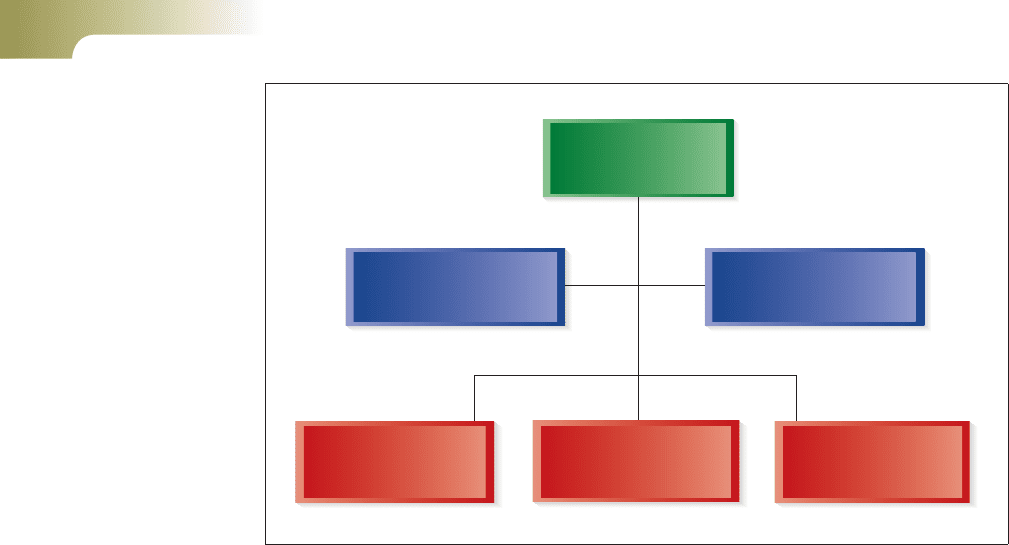Hitt M.A., Ireland R.D., Hoskisson R.E. Strategic Management: Competitiveness and Globalization: Concepts
Подождите немного. Документ загружается.


358
Part 3: Strategic Actions: Strategy Implementation
restricted knowledge base, long-tenured top executives typically develop fewer alternatives
to evaluate in making strategic decisions.
56
However, long-tenured managers also may
be able to exercise more effective strategic control, thereby obviating the need for
board members’ involvement because effective strategic control generally produces
higher performance.
57
Intriguingly, recent findings suggest that “the liabilities of short
tenure … appear to exceed the advantages, while the advantages of long tenure—firm-
specific human and social capital, knowledge, and power—seem to outweigh the dis-
advantages of rigidity and maintaining the status quo.”
58
Overall then the relationship
between CEO tenure and firm performance is complex, indicating that to strengthen
the firm, boards of directors should develop an effective relationship with the top
management team.
In summary, the relative degrees of power held by the board and top management
team members should be examined in light of an individual firm’s situation. For exam-
ple, the abundance of resources in a firm’s external environment and the volatility of that
environment may affect the ideal balance of power between the board and the top man-
agement teams. Moreover, a volatile and uncertain environment may create a situation
where a powerful CEO is needed to move quickly, but a diverse top management team
may create less cohesion among team members and prevent or stall necessary strategic
actions. With effective working relationships, boards, CEOs, and other top management
team members have the foundation required to select arrangements with the highest
probability of best serving stakeholders’ interests.
59
Managerial Succession
The choice of top executives—especially CEOs—is a critical decision with important
implications for the firm’s performance.
60
Many companies use leadership screening
systems to identify individuals with managerial and strategic leadership potential as
well as to determine the criteria individuals should satisfy to be candidates for the CEO
position.
61
The most effective of these systems assesses people within the firm and gains valu-
able information about the capabilities of other companies’ managers, particularly their
strategic leaders.
62
Based on the results of these assessments, training and development
programs are provided for current individuals in an attempt to preselect and shape the
skills of people who may become tomorrow’s leaders. Because of the quality of its pro-
grams, General Electric “is famous for developing leaders who are dedicated to turning
imaginative ideas into leading products and services.”
63
Organizations select managers and strategic leaders from two types of managerial
labor markets—internal and external.
64
An internal managerial labor market consists
of a firm’s opportunities for managerial positions and the qualified employees within
that firm. An external managerial labor market is the collection of managerial career
opportunities and the qualified people who are external to the organization in which the
opportunities exist.
Several benefits are thought to accrue to a firm when the internal labor market is used
to select an insider as the new CEO. Because of their experience with the firm and the
industry environment in which it competes, insiders are familiar with company prod-
ucts, markets, technologies, and operating procedures. Also, internal hiring produces
lower turnover among existing personnel, many of whom possess valuable firm-specific
knowledge. When the firm is performing well, internal succession is favored to sustain
high performance. It is assumed that hiring from inside keeps the important knowledge
necessary to sustain performance.
Results of work completed by management consultant Jim Collins support the value of
using the internal labor market when selecting a CEO. Collins found that high-performing
firms almost always appoint an insider to be the new CEO. He argues that bringing in a
An internal managerial
labor market consists of
a fi rm’s opportunities for
managerial positions and
the qualifi ed employees
within that fi rm.
An external managerial
labor market is the
collection of managerial
career opportunities and
the qualifi ed people
who are external to the
organization in which the
opportunities exist.

359
Chapter 12: Strategic Leadership
well-known outsider, to whom he refers as a “white knight,” is a recipe for mediocrity.
65
For example, given the phenomenal success of General Electric (GE) during Jack Welch’s
tenure as CEO and the firm’s highly effective management and leadership development
programs, insider Jeffrey Immelt was chosen to succeed Welch. However, sharehold-
ers have become disgruntled because GE’s stock values have decreased in recent years;
GE has suffered along with many other firms in the global economic crisis experienced
in 2008 and 2009. Thus, GE under Immelt’s leadership is not experiencing the returns
achieved by his predecessor.
Employees commonly prefer the internal managerial labor market when selecting
top management team members and a new CEO. In the past, companies have also had
a preference for insiders to fill top-level management positions because of a desire for
continuity and a continuing commitment to the firm’s current vision, mission, and cho-
sen strategies.
66
However, because of a changing competitive landscape and varying levels
of performance, an increasing number of boards of directors are turning to outsiders to
succeed CEOs. Although the circumstances are rather unique, Ed Whitacre, former CEO
of AT&T was chosen to be the new chairman for GM. Of course, he will have to help GM
come out of bankruptcy.
67
A firm often has valid reasons to select an outsider as its new
CEO. In some situations, long tenure with a firm may reduce strategic leaders’ level of
commitment to pursue innovation. Given innovation’s importance to firm success (see
Chapter 13), this hesitation could be a liability for a strategic leader.
In Figure 12.3, we show how the composition of the top management team and the
CEO succession (managerial labor market) interact to affect strategy. For example, when
the top management team is homogeneous (its members have similar functional experi-
ences and educational backgrounds) and a new CEO is selected from inside the firm, the
firm’s current strategy is unlikely to change. Alternatively, when a new CEO is selected
from outside the firm and the top management team is heterogeneous, the probability is
high that strategy will change. When the new CEO is from inside the firm and a hetero-
geneous top management team is in place, the strategy may not change, but innovation
is likely to continue. An external CEO succession with a homogeneous team creates a
more ambiguous situation. The selection of Sir Howard Stringer as CEO of Sony signaled
major changes in that firm’s future. He is not only an outsider but also a foreigner. He
is making major changes in the hopes of turning around Sony’s poor performance. His
intent is to have Sony regain its traditional excellence in innovative products.
68
To p
Management
Team
Composition
Stable
strategy
Ambiguous:
possible change in
top management
team and strategy
Stable strategy
with innovation
Strategic
change
Homogeneous
Heterogeneous
Internal CEO
succession
External CEO
succession
Managerial Labor Market:
CEO Succession
Figure 12.3 Effects of CEO Succession and Top Management Team Composition on Strategy

Anne Mulcahy became CEO of Xerox in 2001
and is credited with restoring the company’s
profitability and market leadership during her
tenure. She championed innovation and built a strong relationship with customers. In fact,
the firm was close to bankruptcy when she became the CEO. She told Xerox shareholders
that the company’s business model at the time was not sustainable. She was advised to
declare bankruptcy but refused to do so. To gain the support needed for changes, she had
personal meetings with the top 100 managers at Xerox. She refused to cut R&D or sales but
did reduce costs significantly in other areas. The lead independent director, N. J. Nicholas,
believes she created a major turnaround that built Xerox into an innovative technology and
services company. Her work as CEO has earned her recognition as one of America’s best
leaders.
The succession process she has used reinforces that recognition. Ursula Burns was
selected as heir apparent and given the job as president to “learn the ropes” for a couple
of years before Mulcahy decided to take early retirement (Mulcahy was only 56 years old in
2009). Actually, Burns played a major role in Xerox’s turnaround. She served as Mulcahy’s
lieutenant and managed most of the day-to-day operations. She also helped to identify
gaps in Xerox’s product portfolio and found products to fill those gaps. With the largest
product portfolio in Xerox’s history, it became a major competitor in marketing products to
small and medium-sized businesses. Interestingly, Burns
is the first African-American woman to head a major U.S.
corporation. Burns (CEO) and Mulcahy (Chairman) are
planning to work as a team for a couple of years. This
is probably good because Xerox faces multiple chal-
lenges given the negative economic environment. Burns
receives praise from insiders and external analysts for
her deep knowledge of the industry and business and
her technological expertise. She is also known for her
willingness to take risks. One observer called the selec-
tion of Burns and model transition between Mulcahy
and Burns as a “bases-loaded home run.” Xerox is a
unique technology-based company because approxi-
mately one third of its almost 4,000 executives are
women. Observers expect the transition from Mulcahy to
Burns to be a major success.
Sources: N. Byrnes and R. O. Crockett, 2009, An historic succession
at Xerox, BusinessWeek, June 8, 18–22; W. M. Bulkeley, 2009, Xerox
names Burns chief as Mulcahy retires early, Wall Street Journal, http://
www.wsj.com, May 22; 2009, Chief executive is retiring at Xerox, New
York Times, http://www.nytimes.com, May 22; 2009, Anne Mulcahy to
retire as Xerox CEO; Ursula Burns named successor, FreshNews, http://
www.freshnews.com, May 21; E. White, 2009, Xerox succession a ‘model’
case, Wall Street Journal, http://www.wsj.com, May 21; D. Gelles, 2009,
Burns to replace Mulcahy at Xerox, Financial Times, http://www.ft.com,
May 21; 2008, Women CEOs, Xerox, Financial Times, http://www.ft.com,
December 31; B. George, 2008, America’s best leaders: Anne Mulcahy,
Xerox CEO, US News, http://www.usnews.com, November 19.
THE MODEL SUCCESSION
AT XEROX
Jeff Weiner/Courtesy of Xerox Corporation
Nik Rocklin/Courtesy of Xerox Corporation
Anne Mulcahy, Chairman of Xerox
Ursula Burns, CEO of Xerox

361
Chapter 12: Strategic Leadership
Including talent from all parts of both the internal and external labor markets
increases the likelihood that the firm will be able to form an effective top-management
team. Evidence suggests that women are a qualified source of talent as strategic leaders
that have been somewhat overlooked. In light of the success of a growing number of
female executives, the foundation for change may be established. Trailblazers such as
Catherine Elizabeth Hughes (the first African-American woman to head a firm that was
publicly traded on a U.S. stock exchange), Muriel Siebert (the first woman to purchase a
seat on the New York Stock Exchange), and publisher Judith Regan have made important
contributions as strategic leaders. Recent years have produced several prominent female
CEOs, such as Anne Mulcahy (Xerox Corporation), Meg Whitman (eBay), and Andrea
Jung (Avon Products). As noted in the Strategic Focus, Anne Mulcahy stepped out of the
role of CEO and became chairman of the board for Xerox in 2009. Ursula Burns suc-
ceeded her as the CEO.
Managerial talent is critical to a firm’s success as noted earlier. And, one area in which
managerial talent is crucial is in the integration of an acquired firm into the acquiring
business. In fact, the top management team of an acquired firm is vital to a successful
integration process because they play a critical role in helping the change be implemented
and accepted by the acquired firm’s employees.
69
However, it is common for there to be
major turnover among the top management team of acquired firms. Sometimes it occurs
because the acquiring firm unwisely replaces them. In other cases, the managers depart
voluntarily to seek other top management positions. Research shows that high turnover
among the acquired firm’s top managers often produces poor performance and perhaps
even leads to a failed acquisition.
70
Therefore, acquiring firms should work hard to avoid
successions during the integration process and thereafter.
Key Strategic Leadership Actions
Certain actions characterize effective strategic leadership; we present the most important
ones in Figure 12.4. Many of the actions interact with each other. For example, manag-
ing the firm’s resources effectively includes developing human capital and contributes to
establishing a strategic direction, fostering an effective culture, exploiting core compe-
tencies, using effective organizational control systems, and establishing ethical practices.
The most effective strategic leaders create viable options in making decisions regarding
each of the key strategic leadership actions.
71
Determining Strategic Direction
Determining strategic direction involves specifying the image and character the firm
seeks to develop over time.
72
The strategic direction is framed within the context of the
conditions (i.e., opportunities and threats) strategic leaders expect their firm to face in
roughly the next three to five years.
The ideal long-term strategic direction has two parts: a core ideology and an envi-
sioned future. The core ideology motivates employees through the company’s heritage,
but the envisioned future encourages employees to stretch beyond their expectations
of accomplishment and requires significant change and progress to be realized.
73
The
envisioned future serves as a guide to many aspects of a firm’s strategy implementation
process, including motivation, leadership, employee empowerment, and organizational
design. The strategic direction could include such actions as entering new international
markets and developing a set of new suppliers to add to the firm’s value chain.
74
Most changes in strategic direction are difficult to design and implement; however,
CEO Jeffrey Immelt has an even greater challenge at GE. GE performed exceptionally
well under Jack Welch’s leadership. Although change is necessary because the competi-
tive landscape has shifted significantly, stakeholders accustomed to Jack Welch and high
performance are experiencing problems in accepting Immelt’s changes (e.g., changes to
Determining strategic
direction involves
specifying the image
and character the fi rm
seeks to develop over
time.

362
Part 3: Strategic Actions: Strategy Implementation
Emphasizing
Ethical Practices
Effectively
Managing the Firm’s
Resource Portfolio
Sustaining
an Effective
Organizational Culture
Establishing Balanced
Organizational Controls
Determining
Strategic Direction
Effective Strategic
Leadership
Figure 12.4 Exercise of Effective Strategic Leadership
the firm’s corporate-level strategy and structure). His challenges are made even more dif-
ficult because GE is experiencing performance problems partly the result of the difficult
economic climate.
75
Additionally, information regarding the firm’s strategic direction
must be consistently and clearly communicated to all affected parties.
76
A charismatic CEO may foster stakeholders’ commitment to a new vision and strate-
gic direction. Nonetheless, it is important not to lose sight of the organization’s strengths
when making changes required by a new strategic direction. Immelt, for example, needs
to use GE’s strengths to ensure continued positive performance. The goal is to pursue the
firm’s short-term need to adjust to a new vision and strategic direction while maintaining
its long-term survivability by effectively managing its portfolio of resources.
Effectively Managing the Firm’s Resource Portfolio
Effectively managing the firm’s portfolio of resources may be the most important stra-
tegic leadership task. The firm’s resources are categorized as financial capital, human
capital, social capital, and organizational capital (including organizational culture).
77
Clearly, financial capital is critical to organizational success; strategic leaders
understand this reality.
78
However, the most effective strategic leaders recognize the
equivalent importance of managing each remaining type of resource as well as managing
the integration of resources (e.g., using financial capital to provide training opportunities
through which human capital is able to learn and maximize its performance). Most
importantly, effective strategic leaders manage the firm’s resource portfolio by organizing
them into capabilities, structuring the firm to facilitate using those capabilities, and
choosing strategies through which the capabilities are successfully leveraged to create
value for customers.
79
Exploiting and maintaining core competencies and developing and
retaining the firm’s human and social capital are actions taken to reach these important
objectives.
Exploiting and Maintaining Core Competencies
Examined in Chapters 1 and 3, core competencies are capabilities that serve as a source
of competitive advantage for a firm over its rivals. Typically, core competencies relate
to an organization’s functional skills, such as manufacturing, finance, marketing, and

363
Chapter 12: Strategic Leadership
research and development. Strategic leaders must verify that the firm’s competencies are
emphasized when implementing strategies. Intel, for example, has core competencies
of competitive agility (an ability to act in a variety of competitively relevant ways) and
competitive speed (an ability to act quickly when facing environmental and competitive
pressures).
80
Capabilities are developed over time as firms learn from their actions and
enhance their knowledge about specific actions needed. For example, through repeated
interactions, some firms have formed a capability allowing them to fully understand
customers’ needs as they change.
81
Firms with capabilities in R&D that develop into core
competencies are rewarded by the market because of the critical nature of innovation in
many industries.
82
In many large firms, and certainly in related diversified ones, core competencies are
effectively exploited when they are developed and applied across different organizational
units (see Chapter 6). For example, PepsiCo purchased Quaker Oats (now called Quaker
Foods), which makes the sports drink Gatorade. PepsiCo uses its competence in distribu-
tion systems to exploit the Quaker assets. In this instance, Pepsi soft drinks (e.g., Pepsi
Cola and Mountain Dew) and Gatorade share the logistics activity. Similarly, PepsiCo
uses this competence to distribute Quaker’s healthy snacks and Frito-Lay salty snacks
through the same channels. Today, PepsiCo seeks “to be the world’s premiere consumer
products company focused on convenient foods and beverages.”
83
Firms must continuously develop and, when appropriate, change their core com-
petencies to outperform rivals. If they have a competence that provides an advantage
but does not change it, competitors will eventually imitate that competence and reduce
or eliminate the firm’s competitive
advantage. Additionally, firms must
guard against the competence becom-
ing a liability, thereby preventing
change.
As we discuss next, human capi-
tal is critical to a firm’s success. One
reason it’s so critical is that human
capital is the resource through which
core competencies are developed and
used.
Developing Human Capital and
Social Capital
Human capital refers to the knowledge
and skills of a firm’s entire workforce.
From the perspective of human
capital, employees are viewed as a
capital resource requiring continuous
investment.
84
At PepsiCo, people are identified as the key to the firm’s continuing success.
Given the need to “sustain its talent,” PepsiCo invests in its human capital in the form of
a host of programs and development-oriented experiences.
85
Investments such as those being made at PepsiCo are productive, in that much of the
development of U.S. industry can be attributed to the effectiveness of its human capital.
This fact suggests that “as the dynamics of competition accelerate, people are perhaps the
only truly sustainable source of competitive advantage.”
86
In all types of organizations—
large and small, new and established, and so forth—human capital’s increasing impor-
tance suggests a significant role for the firm’s human resource management activities.
87
As a support activity (see Chapter 3), human resource management practices facilitate
people’s efforts to successfully select and especially to use the firm’s strategies.
88
Effective training and development programs increase the probability of individuals
becoming successful strategic leaders.
89
These programs are increasingly linked to firm
Human capital refers
to the knowledge and
skills of a fi rm’s entire
workforce.
Training and
development pro-
grams can provide
the means by which
new strategic lead-
ers are cultivated
within an organiza-
tion.
Dave & Les Jacobs/Cultura/Getty Images

364
Part 3: Strategic Actions: Strategy Implementation
success as knowledge becomes more integral to gaining and sustaining a competitive
advantage.
90
Additionally, such programs build knowledge and skills, inculcate a
common set of core values, and offer a systematic view of the organization, thus pro-
moting the firm’s vision and organizational cohesion. For example, PepsiCo’s develop-
ment programs emphasize its “performance with purpose,” which focuses on building
shareholder value while simultaneously ensuring human, environmental, and talent
sustainability.
91
Effective training and development programs also contribute positively to the firm’s
efforts to form core competencies.
92
Furthermore, they help strategic leaders improve
skills that are critical to completing other tasks associated with effective strategic leader-
ship, such as determining the firm’s strategic direction, exploiting and maintaining the
firm’s core competencies, and developing an organizational culture that supports ethical
practices. Thus, building human capital is vital to the effective execution of strategic lead-
ership. Indeed, some argue that the world’s “best companies are realizing that no matter
what business they’re in, their real business is building leaders.”
93
Strategic leaders must acquire the skills necessary to help develop human capital in
their areas of responsibility.
94
When human capital investments are successful, the result
is a workforce capable of learning continuously. Continuous learning and leveraging the
firm’s expanding knowledge base are linked with strategic success.
95
Learning also can preclude making errors. Strategic leaders tend to learn more from
their failures than their successes because they sometimes make the wrong attributions
for the successes.
96
For example, the effectiveness of certain approaches and knowledge
can be context specific.
97
Thus, some “best practices” may not work well in all situations.
We know that using teams to make decisions can be effective, but sometimes it is better
for leaders to make decisions alone, especially when the decisions must be made and
implemented quickly (e.g., in crisis situations).
98
Thus, effective strategic leaders recog-
nize the importance of learning from success and from failure.
Learning and building knowledge are important for creating innovation in firms.
99
Innovation leads to competitive advantage. Overall, firms that create and maintain
greater knowledge usually achieve and maintain competitive advantages. However, as
noted with core competencies, strategic leaders must guard against allowing high levels
of knowledge in one area to lead to myopia and overlooking knowledge development
opportunities in other important areas of the business.
100
When facing challenging conditions, firms sometimes decide to lay off some of their
human capital. Strategic leaders must recognize though that layoffs can result in a sig-
nificant loss of the knowledge possessed by the firm’s human capital. Research evidence
shows that moderate-sized layoffs may improve firm performance, but large layoffs pro-
duce stronger performance downturns in firms because of the loss of human capital.
101
Although it is also not uncommon for restructuring firms to reduce their expenditures
on or investments in training and development programs, restructuring may actually be
an important time to increase investments in these programs. The reason for increased
focus on training and development is that restructuring firms have less slack and cannot
absorb as many errors; moreover, the employees who remain after layoffs may find them-
selves in positions without all the skills or knowledge they need to perform the required
tasks effectively.
Viewing employees as a resource to be maximized rather than as a cost to be minimized
facilitates successful implementation of a firm’s strategies as does the strategic leader’s
ability to approach layoffs in a manner that employees believe is fair and equitable.
102
A critical issue for employees is the fairness in the layoffs and in treatment in their
jobs.
103
Social capital involves relationships inside and outside the firm that help the firm
accomplish tasks and create value for customers and shareholders.
104
Social capital
is a critical asset for a firm. Inside the firm, employees and units must cooperate to
get the work done. In multinational organizations, employees often must cooperate
Social capital involves
relationships inside and
outside the fi rm that
help the fi rm accomplish
tasks and create value
for customers and
shareholders.

365
Chapter 12: Strategic Leadership
across country boundaries on activities such as R&D to achieve performance objectives
(e.g., developing new products).
105
External social capital is increasingly critical to firm success. The reason for this is
that few if any companies have all of the resources they need to successfully compete against
their rivals. Firms can use cooperative strategies such as strategic alliances (see Chapter 9)
to develop social capital. Social capital can develop in strategic alliances as firms share
complementary resources. Resource sharing must be effectively managed, though, to
ensure that the partner trusts the firm and is willing to share the desired resources.
106
Research evidence suggests that the success of many types of firms may partially
depend on social capital. Large multinational firms often must establish alliances in order
to enter new foreign markets. Likewise, entrepreneurial firms often must establish alli-
ances to gain access to resources, venture capital, or other types of resources (e.g., special
expertise that the entrepreneurial firm cannot afford to maintain in-house).
107
Retaining
quality human capital and maintaining strong internal social capital can be affected
strongly by the firm’s culture.
Sustaining an Effective Organizational Culture
In Chapter 1, we define organizational culture as a complex set of ideologies, symbols,
and core values that are shared throughout the firm and influence the way business
is conducted. Evidence suggests that a firm can develop core competencies in terms
of both the capabilities it possesses and the way the capabilities are leveraged when
implementing strategies to produce desired outcomes. In other words, because the
organizational culture influences how the firm conducts its business and helps regulate
and control employees’ behavior, it can be a source of competitive advantage
108
and is
a “critical factor in promoting innovation.”
109
Given its importance, it may be that a
vibrant organizational culture is the most valuable competitive differentiator for busi-
ness organizations. Thus, shaping the context within which the firm formulates and
implements its strategies—that is, shaping the organizational culture—is an essential
strategic leadership action.
110
Entrepreneurial Mind-Set
Especially in large organizations, an organizational culture often encourages (or discour-
ages) strategic leaders from pursuing (or not pursuing) entrepreneurial opportunities.
111
This issue is important because entrepreneurial opportunities are a vital source of growth
and innovation.
112
Therefore, a key role of strategic leaders is to encourage and promote
innovation by pursuing entrepreneurial opportunities.
113
One way to encourage innovation is to invest in opportunities as real options—that
is, invest in an opportunity in order to provide the potential option of taking advantage
of the opportunity at some point in the future.
114
For example, a firm might buy a piece of
land to have the option to build on it at some time in the future should the company need
more space and should that location increase in value to the company. Firms might enter
strategic alliances for similar reasons. In this instance, a firm might form an alliance to
have the option of acquiring the partner later or of building a stronger relationship with
it (e.g., developing a joint new venture).
115
In Chapter 13, we describe how large firms use strategic entrepreneurship to pursue
entrepreneurial opportunities and to gain first-mover advantages. Small and medium-
sized firms also rely on strategic entrepreneurship when trying to develop innovations as
the foundation for profitable growth. In firms of all sizes, strategic entrepreneurship is
more likely to be successful when employees have an entrepreneurial mind-set.
116
Five dimensions characterize a firm’s entrepreneurial mind-set: autonomy, innova-
tiveness, risk taking, proactiveness, and competitive aggressiveness.
117
In combination,
these dimensions influence the actions a firm takes to be innovative and launch new
ventures. In sum, strategic leaders with an entrepreneurial mind-set are committed to
pursuing profitable growth.
118
An organizational
culture consists of
a complex set of
ideologies, symbols,
and core values that
are shared throughout
the fi rm and infl uence
the way business is
conducted.

366
Part 3: Strategic Actions: Strategy Implementation
Autonomy, the first of an entrepreneurial orientation’s five dimensions, allows
employees to take actions that are free of organizational constraints and permits indi-
viduals and groups to be self-directed. The second dimension, innovativeness, “reflects a
firm’s tendency to engage in and support new ideas, novelty, experimentation, and cre-
ative processes that may result in new products, services, or technological processes.”
119
Cultures with a tendency toward innovativeness encourage employees to think beyond
existing knowledge, technologies, and parameters to find creative ways to add value. Risk
taking reflects a willingness by employees and their firm to accept risks when pursuing
entrepreneurial opportunities. Assuming significant levels of debt and allocating large
amounts of other resources (e.g., people) to projects that may not be completed are
examples of these risks. The fourth dimension of an entrepreneurial orientation, proac-
tiveness, describes a firm’s ability to be a market leader rather than a follower. Proactive
organizational cultures constantly use processes to anticipate future market needs and to
satisfy them before competitors learn how to do so. Finally, competitive aggressiveness is
a firm’s propensity to take actions that allow it to consistently and substantially outper-
form its rivals.
120
Changing the Organizational Culture and Restructuring
Changing a firm’s organizational culture is more difficult than maintaining it; how-
ever, effective strategic leaders recognize when change is needed. Incremental changes
to the firm’s culture typically are used to implement strategies.
121
More significant and
sometimes even radical changes to organizational culture support selecting strategies
that differ from those the firm has implemented historically. Regardless of the reasons
for change, shaping and reinforcing a new culture require effective communication and
problem solving, along with selecting the right people (those who have the values desired
for the organization), engaging in effective performance appraisals (establishing goals
and measuring individual performance toward goals that fit in with the new core values),
and using appropriate reward systems (rewarding the desired behaviors that reflect the
new core values).
122
Evidence suggests that cultural changes succeed only when the firm’s CEO, other key
top management team members, and middle-level managers actively support them.
123
To effect change, middle-level managers in particular need to be highly disciplined to
energize the culture and foster alignment with the strategic vision.
124
In addition, man-
agers must be sensitive to the effects of other major strategic changes on organizational
culture. For example, major downsizings can have negative effects on an organization’s
culture, especially if it is not implemented in accordance with the dominant organiza-
tional values.
125
Emphasizing Ethical Practices
The effectiveness of processes used to implement the firm’s strategies increases when
they are based on ethical practices. Ethical companies encourage and enable people at all
organizational levels to act ethically when doing what is necessary to implement strate-
gies. In turn, ethical practices and the judgment on which they are based create “social
capital” in the organization, increasing the “goodwill available to individuals and groups”
in the organization.
126
Alternatively, when unethical practices evolve in an organization,
they may become acceptable to many managers and employees.
127
One study found that
in these circumstances, managers were particularly likely to engage in unethical practices
to meet their goals when current efforts to meet them were insufficient.
128
To properly influence employees’ judgment and behavior, ethical practices must
shape the firm’s decision-making process and must be an integral part of organizational
culture. In fact, research evidence suggests that a value-based culture is the most effec-
tive means of ensuring that employees comply with the firm’s ethical requirements.
129
As we explained in Chapter 10, managers may act opportunistically, making decisions
that are in their own best interests but not in the firm’s best interests when facing lax

367
Chapter 12: Strategic Leadership
expectations regarding ethical behavior. In other words, managers acting opportunistically
take advantage of their positions, making decisions that benefit themselves to the detri-
ment of the firm’s stakeholders.
130
But strategic leaders are most likely to integrate
ethical values into their decisions when the company has explicit ethics codes, the code is
integrated into the business through extensive ethics training, and shareholders expect
ethical behavior.
131
Firms should employ ethical strategic leaders—leaders who include ethical practices
as part of their strategic direction for the firm, who desire to do the right thing, and for
whom honesty, trust, and integrity are important.
132
Strategic leaders who consistently
display these qualities inspire employees as they work with others to develop and sup-
port an organizational culture in which ethical practices are the expected behavioral
norms.
133
Strategic leaders can take several actions to develop an ethical organizational culture.
Examples of these actions include (1) establishing and communicating specific goals
to describe the firm’s ethical standards (e.g., developing and disseminating a code of
conduct); (2) continuously revising and updating the code of conduct, based on inputs
from people throughout the firm and from other stakeholders (e.g., customers and sup-
pliers); (3) disseminating the code of conduct to all stakeholders to inform them of the
firm’s ethical standards and practices; (4) developing and implementing methods and
procedures to use in achieving the firm’s ethical standards (e.g., using internal auditing
practices that are consistent with the standards); (5) creating and using explicit reward
systems that recognize acts of courage (e.g., rewarding those who use proper channels
and procedures to report observed wrongdoings); and (6) creating a work environment
in which all people are treated with dignity.
134
The effectiveness of these actions increases
when they are taken simultaneously and thereby are mutually supportive. When strate-
gic leaders and others throughout the firm fail to take actions such as these—perhaps
because an ethical culture has not been created—problems are likely to occur. As we
discuss next, formal organizational controls can help prevent further problems and rein-
force better ethical practices.
135
Establishing Balanced Organizational Controls
Organizational controls are basic to a capitalistic system and have long been viewed as
an important part of strategy implementation processes.
136
Controls are necessary to help
ensure that firms achieve their desired outcomes.
137
Defined as the “formal, information-
based … procedures used by managers to maintain or alter patterns in organizational
activities,” controls help strategic leaders build credibility, demonstrate the value of
strategies to the firm’s stakeholders, and promote and support strategic change.
138
Most
critically, controls provide the parameters for implementing strategies as well as the cor-
rective actions to be taken when implementation-related adjustments are required.
In this chapter, we focus on two organizational controls—strategic and financial—that
were introduced in Chapter 11. Our discussion of organizational controls here empha-
sizes strategic and financial controls because strategic leaders, especially those at the top
of the organization, are responsible for their development and effective use.
As we explained in Chapter 11, financial control focuses on short-term financial out-
comes. In contrast, strategic control focuses on the content of strategic actions rather
than their outcomes. Some strategic actions can be correct but still result in poor financial
outcomes because of external conditions such as a recession in the economy, unexpected
domestic or foreign government actions, or natural disasters. Therefore, emphasizing
financial controls often produces more short-term and risk-averse managerial decisions,
because financial outcomes may be caused by events beyond managers’ direct control.
Alternatively, strategic control encourages lower-level managers to make decisions
that incorporate moderate and acceptable levels of risk because outcomes are shared
between the business-level executives making strategic proposals and the corporate-level
executives evaluating them.
